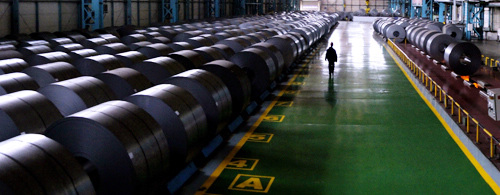|
 |
|
LEAPS AND BOUNDS: A worker walks past steel plates in Baotou Iron and Steel Group in the Inner Mongolia Autonomous Region. The company's steel output reached 10.22 million tons in 2011. It took the company six years to raise its annual steel output from 5 million to last year's level (ZHAO TINGTING) |
According to the PBOC, gross yuan loans outstanding increased 15.2 percent year on year to 56.24 trillion yuan ($8.93 trillion) in February, down 2.5 percentage points from a year earlier. Chinese financial institutions issued 710.7 billion yuan ($112.81 billion) in loans in February this year, up 173 billion yuan ($27.46 billion) year on year. The lower-than-expected figure for new lending was down from 738.1 billion yuan ($117.16 billion) in January, and below the 800-billion-yuan ($127 billion) growth predicted by many economists. Analysts said the anti-inflation efforts will also restrain the possibility of major credit increases in the future.
"The lower-than-expected lending triggered concerns that industrial production and fixed asset investment may decrease and finally cause a sharp slowdown in the economy," said the BOC report.
While Chinese residents suffer from property price hikes, the BOC report also listed it as the major risk endangering the Chinese economy.
The BOC report said that housing prices have come down and sales picked up in China, which shows that the government's efforts to prevent the Chinese property market from overheating have enjoyed success.
On the other hand, housing prices are still too high for average people and many people's reasonable consumption was affected by the adjustment measures, which store up problems for the burst of the property bubble in the future, and its effect on the Chinese economy will be widespread, said the report.
While the BOC warns of the risks and malaise in the Chinese economy, other research has provided reasons to be sanguine. International Monetary Fund (IMF) released its latest Global and Regional Economic and Financial Outlook on May 8 in Beijing. According to the IMF report, the world economy is expected to improve during the latter half of this year and China will see an average 8.2-percent growth in its economy this year. It also predicted that China would not suffer a hard landing this year and its growth would pick up in the second half of this year.
According to figures released by the National Bureau of Statistics and China Federation of Logistics & Purchasing, China's purchasing managers' index for manufacturing rose to 53.3 in April, the highest in more than a year. That also marks the index's fifth straight month above the 50 level, which of course signals an expansion of industrial activities across China.
Cai Jin, Vice President of China Federation of Logistics & Purchasing, said, "We believe the five consecutive months of increases in the PMI number, though in a narrow margin, shows that China's economic growth in the second quarter will be stronger than in the first quarter."
According to Dong Xian'an, chief economist at the Beijing First Advisory Co. Ltd., the biggest risk for the Chinese economy is lackluster overseas demand.
China's foreign trade rose 2.7 percent year on year to $308.08 billion in April, with a surplus of $18.42 billion, the General Administration of Customs said on May 10. The growth rate represents a slowdown from the double-digit rate logged before the financial crisis in 2008. Exports amounted to $163.25 billion in April, up 4.9 percent year on year, while imports edged up 0.3 percent to reach $144.83 billion.
At the same time, the spring session of the biannual Canton Fair, or the 111th China Import and Export Fair, closed on May 5, with export transactions down for the first time since 2009.
Debt crisis in EU countries and the tough job market in the United States were among the factors causing the decrease, said Liu Jianjun, spokesman with the fair.
For a good number of Chinese exporters, this year's grim trade figure is not something new. Ever since the financial crisis in 2008, China's export sector has been declining. What they can do is to upgrade their business operation amid diminishing international competitiveness.
According to Jiang Yong, a researcher with China Institutes of Contemporary International Relations, the biggest risk for the Chinese economy is its overdependence on the United States.
"Despite the fact that interdependence has been used to define Sino-U.S. relations in recent years, a serious asymmetrical dependence prevails. China has been too dependent on the United States in market, technology, brand, marketing, finance, talent and even in ideology," Jiang said.
| 